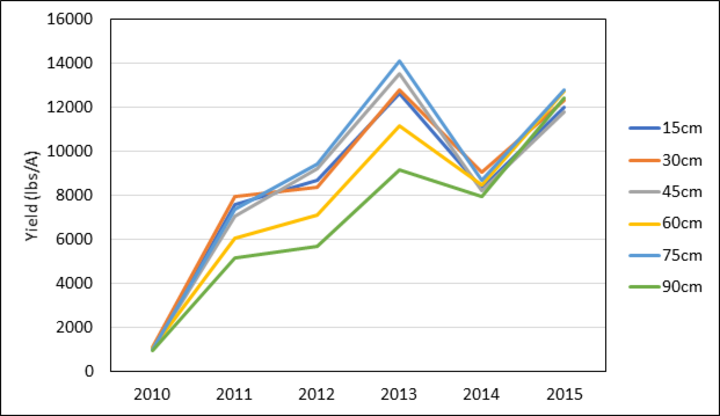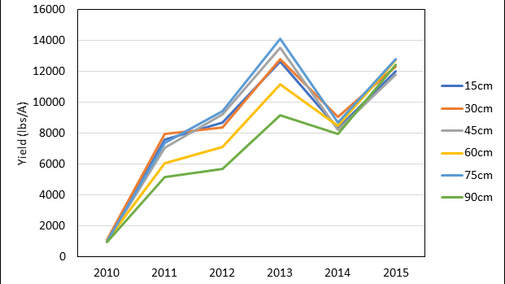Major Findings
- Row spacing had a varying effect on yield depending on the year, but it appears 36-inch rows are too wide and reduce yield.
- ‘Shawnee’ switchgrass had greater nutritive value than ‘Liberty’ switchgrass.
- Row spacing did not appear to affect forage nutritive value.

Why is This Important?
Switchgrass (Panicum virgatum L.) is a native, warm-season perennial used as a forage crop and bioenergy source across the Great Plains and Midwest. It is commonly grown on marginally productive land not suitable for annual crop production. With good management, switchgrass can produce high biomass yields even on marginally productive land. It is long-lived with cost-effective establishment and production costs.
Although yield at the field scale regularly exceeds five tons/acre, switchgrass can be harvested using conventional haying equipment. For hay, switchgrass harvest is recommended at anthesis (around August 1 in eastern Nebraska), but for bioenergy, bedding, or as roughage for feedlot rations, harvest is recommended after a killing frost. Harvesting after frost optimizes nutrient recycling, limits weed problems, and encourages long-term stand persistence.
Proper planting decisions are critical for productive switchgrass stands. Numerous studies have evaluated planting date (three weeks before or after the recommended corn planting date) and seeding rate (30 pure live seed/ft2), but few have evaluated how row spacing at planting affects switchgrass biomass production. A row spacing of 6 to 8 inches is the typical recommendation in eastern Nebraska. These narrow rows encourage the rapid establishment, limit open space for weeds, and result in dense stands. However, for wildlife such as pheasants and quail, these dense stands are not desirable, especially for chicks since movement is restricted and visibility is limited. Additionally, wider row spacings may increase successful legume establishment in the open space created by the wider rows, increasing plant species diversity in the stand. However, if wider row spacings severely limit switchgrass yield, there would be a negative economic consequence to the wider rows.
What Did We Do?
This study was conducted from 2010 to 2015 to evaluate effects of row spacing on switchgrass forage yield. Two switchgrass strains were used in this study, ‘Shawnee’ an upland ecotype and ‘Kanlow x Summer HP1 NETO2 C1’ an experimental lowland ecotype later released as ‘Liberty’. Switchgrass was seeded in 2010 at 30 PLS ft2 using a no-till drill and seeded at 6-, 12-, 18-, 24-, 30-, and 36-inch row spacings (Figure 1). Switchgrass was harvested after a killing frost (the first or second week of November each year) to determine yield. Forage nutritive value was measured using near-infrared reflectance spectroscopy.
What Did We Learn?
Both Shawnee and Liberty had similar yields. This was unexpected since other studies comparing Shawnee and Liberty have seen Liberty yield 40%-50% more biomass than Shawnee. The effects of row spacing on switchgrass yield were mixed. Part of the mixed yield response across the years is due to a severe drought that occurred in 2012 followed by a dry year in 2013. In 2012, the site received only 14.4 inches of precipitation (12 inches below the long-term average), with a total of only 1.9 inches in July, August, and September. This was followed by 23.6 inches in 2013, about 10% below the long-term average.

Due to its deep roots, switchgrass can access water and nutrients to depths greater than 6 feet. Response to drought and depletion of sub-surface soil water can be delayed for one to two years after a severe drought while soil water is recharged. This helps explain the low yield in 2014. Except for the low yield in 2014, yield increased from the establishment year through the end of the study even with two years of drought (2012, 2013). In 2010, 2014, and 2015, yields were similar for both ecotypes at all row spacings. However, in 2011, 2012, and 2013, the 36- and 24-inch row spacings had the lowest yields. During these same years, the 6-inch, 12-inch, and 18-inch row spacings had the greatest yields. Interestingly, yields for the 30-inch row spacing were more similar to the narrower row spacings than the wider row spacings.
Generally, forage nutritive value was not affected by row spacing. However, Shawnee had greater forage nutritive value than Liberty (Figure 2). This was expected since Shawnee was released as a cultivar with increased digestibility compared to other switchgrasses.
So What?
Row spacing did not alter switchgrass nutritive value. However, the effects of row spacing on yield are not so straight forward. Generally, yields were maximized at narrower row spacings (6-inches to 18-inches) and lower at the widest row spacing (36 inches) for both Shawnee and Liberty switchgrass. However, the 30-inch row spacing was at or near the top for yield during all years and 24-inch row spacing was near the bottom.
It appears that switchgrass yield begins to decline at 36-inch row spacings. Based on these results, planting switchgrass in 6-inch, 12-inch, or 18-inch rows resulted in similar yields. However, planting in 30-inch rows may be best if more open space is desired for wildlife or legume inter-seeding without compromising yield.
References
Foster, J.L., J.A. Guretzky, C. Huo, M.K. Kering, and T.J. Butler. 2012. Effects of row spacing, seeding rate, and planting date on establishment of switchgrass. Crop Science 53:309-314.
Keyser, P.D., A.J. Ashworth, F.L. Allen, and G.E. Bates. 2016. Dormant-season planting and seed-dormancy impacts on switchgrass establishment and yield. Crop Science 56:1-10.
Vogel, K. P. 2004. Switchgrass. p. 561-588. In L.E. Moser and L.E. Sollenberger (ed.) Warm-Season (C4) Grasses. Agronomy Monograph no. 45. ASA, CSSA, SSSA, Madison, WI.
Vogel, K.P., R.B. Mitchell, M. Casler, and G. Sarath. 2014. Registration of ‘Liberty’ switchgrass. Journal of Plant Registrations. 8:242–247.
About the Author

Alyssa Kuhn was one of nine undergraduate students completing an Integrated Agronomic Systems Fellowship at the University of Nebraska-Lincoln in summer 2018. She is a senior at Purdue University and will graduate in May 2019. She plans to attend the University of Nebraska and pursue an M.S. degree in the Department of Agronomy and Horticulture.
Acknowledgment
Support for this project was provided by a grant from the USDA NIFA FY15 Agriculture and Food Research Initiative: Education and Literacy Initiative-Undergraduate Experiential Learning Fellowships Program “Developing Research and Extension Skills of Students in Integrated Agronomic Systems.”

